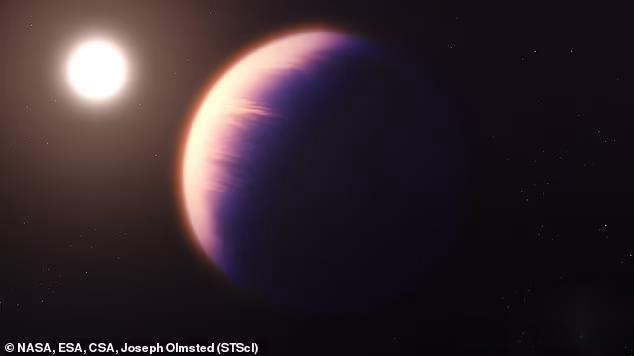
According to a report by NASA on the 25th local time, the James Webb Space Telescope has captured the first clear evidence of carbon dioxide in the atmospheres of exoplanets. The discovery, published in the journal Nature, suggests that future Webb space telescopes may be able to detect and measure carbon dioxide in the thinner atmospheres of smaller rocky planets. 
WASP-39 b is a gas giant planet orbiting its host star. NASA illustration
The exoplanet, WASP-39b, is a hot gas giant orbiting a sun-like star 700 light-years from Earth and about a quarter the mass of Jupiter (roughly the same as Jupiter), NASA noted in a press release. Saturn) and 1.3 times the diameter of Jupiter. Understanding the atmospheric makeup of planets like WASP-39b is critical to understanding how they originated and evolved.
"Carbon dioxide molecules are sensitive tracers in the formation of planets," said team member Mike Lane of Arizona State University.
The team made observations of WASP-39b using Webb's near-infrared spectrometer. In the resulting spectrum of exoplanet atmospheres, a small "hill" between 4.1 and 4.6 microns provided the first clear, detailed evidence that carbon dioxide has been detected on a planet outside our solar system.
According to NASA, no observatory has ever measured so many subtle differences in the brightness of individual colors in the 3 to 5.5 micrometer range in the transmission spectrum of an exoplanet. Obtaining this part of the spectrum is critical for measuring the abundance of gases such as water, methane and carbon dioxide, which are thought to be present in many different types of exoplanets.
NASA's Hubble and Spitzer space telescopes have revealed the presence of water vapor, sodium and potassium in the planet's atmosphere. Now, Webb's infrared sensitivity has also confirmed the presence of carbon dioxide on the planet.
The discovery of carbon dioxide is valuable because it is a clue to a planet's "metallicity," according to the journal Science. Metallic abundance refers to the proportion of matter other than hydrogen and helium that existed in the primordial universe. Hydrogen and helium produced in the Big Bang are the starting materials for all visible matter in the universe, but any heavier matter is later forged in stars. The researchers believe that an adequate supply of heavy elements is essential for the creation of giant planets.
Lane added: "By measuring this signature of carbon dioxide, we can determine how much solid and how much gaseous material was used to form this giant gaseous planet. This measurement will be made on a variety of planets over the next decade. , to gain insight into how planets formed and the uniqueness of our solar system."
(Original title "Exoplanet has carbon dioxide evidence for the first time")
